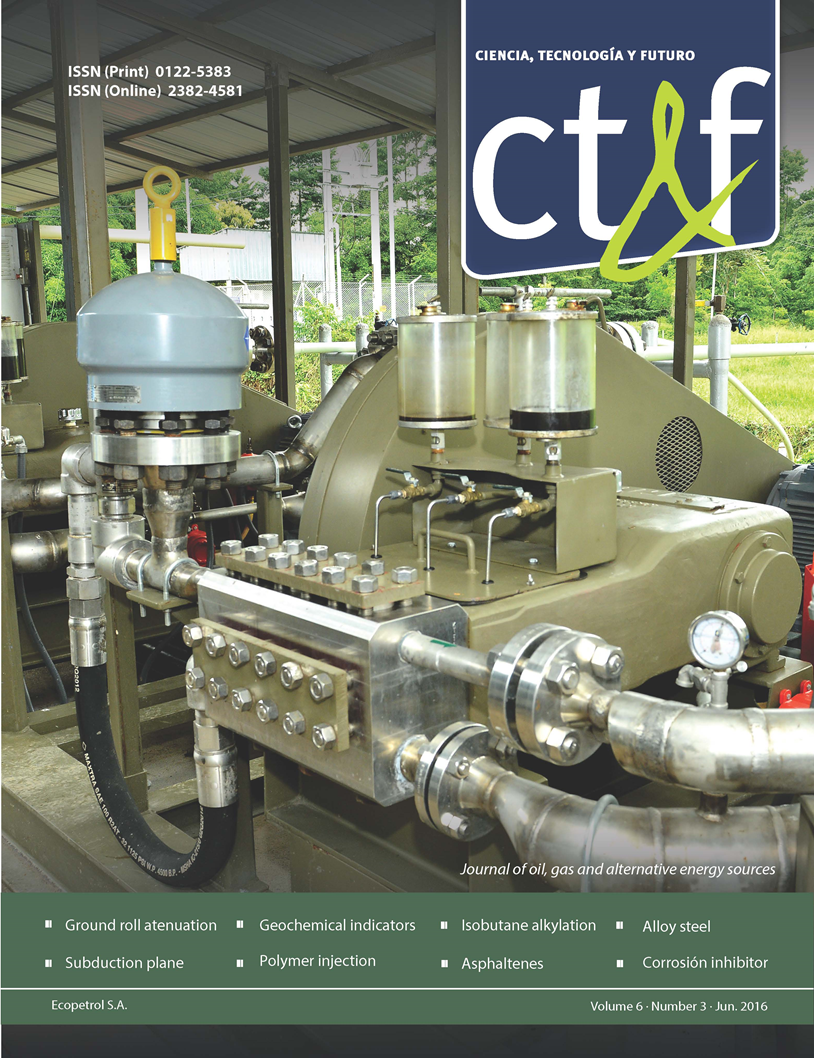Chemical characterization of the asphaltenes from Colombian colorado light crude oil
Abstract
In the present work, we report the chemical characterization of asphaltenes from a light Colombian crude oil, 36° API, Colorado Crude Oil (CCO). Asphaltenes of CCO were extracted using the standard ASTM procedure, ASTM D6560-12. The approach to the chemical composition of asphaltenes was carried out by using elemental analysis (C, H, N, O, S), Fourier transform infrared spectroscopy (FT-IR), Raman Spectroscopy (RS), Matrix Assisted Laser Desorption Ionization - Time of Flight (MALDI-TOF) mass spectrometry, and proton and carbon nuclear magnetic resonance spectroscopy (1H- and 13C-NMR). Finally, the crystallite parameters of nanoaggregates of CCO asphaltenes in solid phase were calculated using X-ray powder diffraction data. The average diameters of aromatic layers La calculated from XRD and Raman were compared together and proved to be in good agreement. Average molecular parameters AMPs were calculated from elemental analysis, NMR and Raman spectroscopies, and X-ray diffractometry.
References
Abdallah, W. A. & Yang, Y. (2012). Raman spectrum of asphaltene. Energy Fuels, 26(11), 6888-6896.
https://doi.org/10.1021/ef301247n
Altgelt, K. & Boduszynski, M. (1994). Composition and analysis of heavy petroleum fractions. New York: Marcel Dekker.
Andersen, S. I., Jensen, J. O. & Speight, J. G. (2005). X-ray diffraction of subfractions of petroleum asphaltenes. Energy Fuels, 19(6), 2371-2377.
https://doi.org/10.1021/ef050039v
Andreatta, G., Goncalves, C. C., Buffin, G., Bostrom, N., Quintella, C. M., Arteaga-Larios, F., Pérez, E. & Mullins, O. C. (2005). Nanoaggregates and structure-function relations in asphaltenes. Energy Fuels, 19(4), 1282-1289.
https://doi.org/10.1021/ef0497762
Asprino, O. J., Elliott, J. A. W., McCaffrey, W. C. & Gray, M. R. (2005). Fluid properties of asphaltenes at 310-530 °C. Energy Fuels, 19(5), 2026-2033.
https://doi.org/10.1021/ef0500484
ASTM D6560-12. Standard Test Method for Determination of Asphaltenes (Heptane Insolubles) in Crude Petroleum and Petroleum Products. Annual Book of ASTM Standarts, Vol 05.03, ASTM International: West Conshohocken, PA, 2012.
Ballard-Andrews, A., Guerra, R. E., Mullins, O. C. & Sen, P. N. (2006). Diffusivity of asphaltene molecules by fluorescence correlation spectroscopy. J. Phys. Chem. A, 110(26), 8093-8097.
https://doi.org/10.1021/jp062099n
Bellamy, L. J. (1957). The infrared spectra of complex molecules. New York: John Wiley & Sons.
Benkhedda, Z., Landais, P., Kister, J., Dereppe, J. M. & Monthioux, M. (1992). Spectroscopic analyses of aromatic hydrocarbons extracted from naturally and artificially matured coals. Energy Fuels, 6(2), 166-172.
https://doi.org/10.1021/ef00032a008
Biktagirov, T. B., Gafurov, M. R., Volodin, M. A., Mamin, G. V., Rodionov, A. A., Izotov, V. V., Vakhin, A. V., Isakov, D. R. & Orlinskii, S. B. (2014). Electron paramagnetic resonance study of rotational mobility of vanadyl porphyrin complexes in crude oil asphaltenes: Probing the effect of thermal treatment of heavy oils. Energy Fuels, 28(10), 6683-6687.
https://doi.org/10.1021/ef5017494
Bouhadda, Y., Bormann, D., Sheu, E., Bendedouch, D., Krallafa, A. & Daaou, M. (2007). Characterization of Algerian Hassi-Messaoud asphaltene structure using Raman spectrometry and X-ray diffraction. Fuel, 86(12), 1855-1864.
https://doi.org/10.1016/j.fuel.2006.12.006
Calemma, V., Rausa, R., D'Anton, P. & Montanari, L. (1998). Characterization of asphaltenes molecular structure. Energy Fuels, 12(2), 422-428.
https://doi.org/10.1021/ef9701854
Chang, C. L. & Fogler, S. (1994). Stabilization of asphaltenes in aliphatic solvents using alkylbenzene-derived amphiphiles. 1. Effect of the chemical structure of amphiphiles on asphaltene stabilization. Langmuir, 10(6), 1749-1757.
https://doi.org/10.1021/la00018a022
Clutter, D. R., Petrakis, L., Stenger, R. L. Jr. & Jensen, R. K. (1972). Nuclear magnetic resonance spectrometry of petroleum fractions. Carbon-13 and proton nuclear magnetic resonance characterizations in terms of average molecule parameters. Anal. Chem., 44(8), 1395-1405.
https://doi.org/10.1021/ac60316a002
Coelho, R. R., Hovell, I., Monte, M. B. M., Middea, A. & De Souza, A. L. (2006). Characterization of aliphatic chainsin vacuum residues (VRs) of asphaltenes and resins using molecular modeling and FTIR techniques. Fuel Process. Technol., 87(4), 325−333.
https://doi.org/10.1016/j.fuproc.2005.10.010
Delpuech, J. J., Nicole, D., Daubenfeld, J. M. & Boudel, J. C. (1985). Method to evaluate benzonaphthenic carbons and donatable hydrogens in fossil fuels. Fuel, 64(3), 325-334.
https://doi.org/10.1016/0016-2361(85)90419-3
Dickie, J. P. & Yen, T. F. (1967). Macrostructures of the asphaltic fractions by various instrumental methods. Anal. Chem., 39(14), 1847-1852.
https://doi.org/10.1021/ac50157a057
Dickinson, E. M. (1980). Structural comparison of petroleum fractions using proton and 13C n.m.r. spectroscopy. Fuel, 59(5), 290-294.
https://doi.org/10.1016/0016-2361(80)90211-2
Ferrari, A. C. & Robertson, J. (2004). Raman spectroscopy in carbons: From nanotubes to diamond. Philos. Trans. R. Soc. A, 362(1824), 2267-2565.
Freed, D. E., Lisitza, N. V., Sen, P. N. & Song, Y. Q. (2007). Molecular composition and dynamics of oils from diffusion measurements. In: Mullins, O. C., Sheu, E. Y., Hammami. A. & Marshall, A. G. (Eds) Asphaltenes, heavy oils, and petroleomics. New York: Springer. 279-299.
https://doi.org/10.1007/0-387-68903-6_11
Gillet, S., Delpuech, J. J., Valentin, P. & Escalier, J. C. (1980). Optimum conditions for crude oil and petroleum product analysis by carbon-13 nuclear magnetic resonance spectrometry. Anal. Chem., 52(6), 813-817.
https://doi.org/10.1021/ac50056a010
Goncalves, S., Castillo, J., Fernández, A. & Hung, J. (2004). Absorbance and fluorescence spectroscopy on the aggregation behavior of asphaltene-toluene solutions. Fuel, 83(13), 1823-1828.
https://doi.org/10.1016/j.fuel.2004.03.009
Goual, L., Sedghi, M., Zeng, H., Mostowfi. F., McFarlane, R. & Mullins, O. C. (2011). On the formation and properties of asphaltene nanoaggregates and clusters by DC-conductivity and centrifugation. Fuel, 90(7), 2480-2490.
https://doi.org/10.1016/j.fuel.2011.02.025
Groenzin, H. & Mullins, O. C. (1999). Asphaltenes molecular size and structure. J. Phys. Chem. A, 103(50), 11237-11245.
https://doi.org/10.1021/jp992609w
Groenzin, H. & Mullins, O. C. (2000). Molecular size and structure of asphaltenes from various sources. Energy Fuels, 14(3), 677-684.
https://doi.org/10.1021/ef990225z
Hirsch, E. & Altgelt, K. H. (1970). Integrated structural analysis. Method for the determination of average structural parameters of petroleum heavy ends. Anal. Chem., 42(12), 1330-1339.
https://doi.org/10.1021/ac60294a005
Hortal, A. R., Hurtado, P., Martínez-Haya, B. & Mullins, O. C. (2007). Molecular-weight distributions of coal and petroleum asphaltenes from laser desorption/ionization experiments. Energy Fuels. 21(5), 2863-2868.
https://doi.org/10.1021/ef700225s
Hsu, C. S., Hendrickson, C. L., Rodgers, R. P., McKenna, A. M. & Marshall, A. G. (2011). Petroleomics: advanced molecular probe for petroleum heavy ends. J. Mass Spectrom., 46(4), 337-343.
https://doi.org/10.1002/jms.1893
Khadim, M. A. & Sarbar, M. A. (1999). Role of asphaltene and resin in oil field emulsions. J. Petrol. Sci. Eng., 23(3- 4), 213-221. Kiet, H. H., Malthotra, S. L. & Blanchard, L. P. (1978). Structure parameter analyses of asphalt fractions by a modified mathematical approach. Anal. Chem., 50(8), 1212-1218.
https://doi.org/10.1016/S0920-4105(99)00024-8
Ladner, W. R. & Snape, C. E. (1978). Application of quantitative 13C nuclear magnetic resonance spectroscopy to coal-derived materials. Fuel, 57(11), 658-662.
https://doi.org/10.1016/0016-2361(78)90016-9
Liang, W., Que, G., Chen, Y. & Liu, C. (2000). Chemical composition and characteristics of residues of Chinese crude oils, development in petroleum science. In: Yen, T. F. & Chilingarian, G. V. Asphaltenes and asphalts. Volume 40B. Los Angele, CA. Elsevier Science, 281-304.
https://doi.org/10.1016/S0376-7361(09)70281-X
Lisitza, N. V., Freed, D. E., Sen, P. N. & Song, Y. Q. (2009). Study of asphaltene nanoaggregates by Nuclear Magnetic Resonance (NMR). Energy Fuels, 23(3), 1189-1193.
https://doi.org/10.1021/ef800631a
Liu, D., Wang, Z., Zhou, J., Deng, W., Liang, S. & Que, G. (2001). Characterization of vacuum residuals and their substitution by using FT-IR techniques. 222nd ACS National Meeting, American Chemistry Society. Symposium on General Papers Presented before the Division of Petroleum Chemistry, Chicago, USA.
McCarley, T. D., McCarley, R. L. & Limbach, P. A. (1998). Electron-transfer ionization in matrix-assisted laser desorption/ionization mass spectrometry. Anal. Chem., 70(20), 4376-4379.
https://doi.org/10.1021/ac980527i
McKenna, A. M., Marshall, A. G. & Rodgers, R. P. (2013). Heavy petroleum composition. 4. Asphaltene compositional space. Energy Fuels, 27(3), 1257-1267.
https://doi.org/10.1021/ef301747d
Medrignac, I., Desmazières, B., Terrier, P., Delobel, A. & Laprévote, O. (2004). Analysis of raw and hydrotreated asphaltenes using off-line and on-line SEC/MS coupling. International Conference of Heavy Organics Deposition. Los Cabos.
Mullins, O. C. (2010). The modified Yen model. Energy Fuels, 24(4), 2179-2207.
https://doi.org/10.1021/ef900975e
Mullins, O. C., Andrews, A. B., Pomerantz, A. E., Dong, C., Zuo, J. Y., Pfeiffer, T., Latifzai, A. S., Elshahawi, H., Barré, L. & Larter, S. (2011). Impact of asphaltene nanoscience on understanding oilfield reservoirs. SPE Annual Technical Conference and Exhibition. Denver.
https://doi.org/10.2118/146649-MS
Mullins, O. C., Betancourt, S. S., Cribbs, M. E., Dubost, F. X., Creek, J. L., Andrews, A. B. & Venkataramanan, L. (2007). The colloidal structure of crude oils and the structure of oil reservoirs. Energy Fuels, 21(5), 2785-2794.
https://doi.org/10.1021/ef0700883
Murgich, J., Rodríguez J. & Aray, Y. (1996). Molecular recognition and molecular mechanics of micelles of some model asphaltenes and resins. Energy Fuels, 10(1), 68-76
https://doi.org/10.1021/ef950112p
Pironon, J., Thiery, R., Ougougdal, M. A., Teinturier, S., Beaudoin, G. & Walgenwitz, F. (2001). FT-IR measurements of petroleum fluid inclusions: methane, n-alkanes and carbon dioxide quantitative analysis. Geofluids, 1(1), 2-10.
https://doi.org/10.1046/j.1468-8123.2001.11002.x
Podgorski, D. C., Corilo, Y. E., Nyadong, L., Lobodin, V. V., Bythell, B. J., Robbins, W. K., McKenna, A. M., Marshall, A. G. & Rodgers, R. P. (2013). Heavy petroleum composition. 5. Compositional and structural continuum of petroleum revealed. Energy Fuels, 27(3), 1268-1276.
https://doi.org/10.1021/ef301737f
Poveda, J. C., Álvarez, I. & Cisneros, C. (2011). Multiphoton ionization of naphthalene clusters at 266 nm. Rev. Mex. Fís., 57(1), 68-74.
Poveda, J. C. & Molina, D. R. (2012). Average molecular parameters of heavy crude oils and their fractions using NMR spectroscopy. J. Petrol. Sci. Eng., 84-85(1), 1-7.
https://doi.org/10.1016/j.petrol.2012.01.005
Poveda, J. C., Molina, D., Martínez, H., Florez, O. & Campillo, B. (2014). Molecular changes in asphaltenes with H2 plasma. Energy Fuels, 28(2), 735-744.
https://doi.org/10.1021/ef401773t
Qian, K., Edwards, K. E., Siski, M., Olmstead, W. N., Mennito, A. S., Dechert, G. J. & Hoosain, N. E. (2007). Desorption and ionization of heavy petroleum molecules and measurement of molecular weight distributions. Energy Fuels. 21(2), 1042-1047. Qian, S. A., Li, C. F. & Zhang, P. Z. (1984). Study of structural parameters on some petroleum aromatic fractions by 1H n.m.r./i.r. and 13C, 1H-n.m.r. spectroscopy. Fuel, 63(2), 268-273.
https://doi.org/10.1021/ef060360t
Rongbao, L., Zengmin, S. & Bailing, L. (1988). Structural analysis of polycyclic aromatic hydrocarbons derived from petroleum and coal by 13C and 1H-n.m.r. spectroscopy. Fuel, 67(4), 565-569.
https://doi.org/10.1016/0016-2361(88)90355-9
Sabbah, H., Morrow, A. L., Pomerantz, A. E. & Zare, R. N. (2011). Evidence for island structures as the dominant architecture of asphaltenes. Energy Fuels, 25(4), 1597- 1604.
https://doi.org/10.1021/ef101522w
Schneider, M. H., Andrews, A. B., Mitra-Kirtley, S. & Mullins, O. C. (2007). Asphaltene molecular size by fluorescence correlation spectroscopy. Energy Fuels, 21(5), 2875-2882.
https://doi.org/10.1021/ef700216r
Sheremata, J., Gray, M. R., Dettman, H. D. & McCaffrey, W. C. (2004). Quantitative molecular representation and sequential optimization of Athabasca asphaltenes. Energy Fuel, 18(5), 1377-1384.
https://doi.org/10.1021/ef049936+
Smith, D. F., Rahimi, P., Teclemariam, A., Rodgers, R. P. & Marshall, A. G. (2008). Characterization of Athabasca bitumen heavy vacuum gas oil distillation cuts by negative/ positive electrospray ionization and automated liquid injection field desorption ionization Fourier transform ion cyclotron resonance mass spectrometry. Energy Fuels, 22(5), 3118-3125.
https://doi.org/10.1021/ef8000357
Strohalm, M., Hassman, M., Košata, B. & Kodíček, M. (2008). mMass data miner: An open source alternative for mass spectrometric data analysis. Rapid Commun. Mass Spectrom. 22(6), 905-908.
https://doi.org/10.1002/rcm.3444
Strohalm, M., Kavan, D., Novák, P., Volný, M. & Havlíček, V. (2010). mMass 3: A cross-platform software environment for precise analysis of mass spectrometric data. Anal. Chem. 82(11), 4648-4651.
https://doi.org/10.1021/ac100818g
Strausz, O. P., Mojelsky, T. W. & Lown, E. M. (1992). The molecular structure of asphaltene: an unfolding story. Fuel, 71(12), 1355-1363.
https://doi.org/10.1016/0016-2361(92)90206-4
Tanaka, R., Sato, E., Hunt, J. E., Winans, R. E., Sato, S. & Takanohashi, T. (2004). Characterization of asphaltene aggregates using X-ray diffraction and small-angle X-ray scattering. Energy Fuels, 18(4), 1118-1125.
https://doi.org/10.1021/ef034082z
Tuinstra, F. & Koenig, J. L. (1970). Raman spectrum of graphite. J. Chem. Phys., 53(3), 1126-1130.
https://doi.org/10.1063/1.1674108
Williams, R. B. (1958). Symposium on composition of petroleum oil, determination and evaluation. ASTM Spec. Tech. Publ., 224, 168-94.
Yen, T. F. (1972). Present status of the structure of petroleum heavy ends and its significance to various technical applications. Am. Chem. Soc. Div. Petrol. Chem. Symposium on advances in analysis of petroleum and its products, Preprints 4, 17(1), 102-114.
Yen, T. F., Erdman, J. G. & Pollack, S. S. (1961). Investigation of the structure of petroleum asphaltenes by X-ray diffraction. Anal. Chem., 33(11), 1587-1594.
https://doi.org/10.1021/ac60179a039
Yoshida, T., Maekawa, Y., Uchino, H. & Yokoyama, S. (1980). Derivation of structural parameters for coal-derived oil by carbon-13 nuclear magnetic resonance spectrometry. Anal. Chem., 52(6), 817-820.
https://doi.org/10.1021/ac50056a011
Zeng, H., Song, Y. Q., Johnson, D. L. & Mullins, O. C. (2009). Critical nanoaggregate concentration of asphaltenes by Direct-Current (DC) electrical conductivity. Energy Fuels, 23(3), 1201-1208.
Downloads
| Article metrics | |
|---|---|
| Abstract views | |
| Galley vies | |
| PDF Views | |
| HTML views | |
| Other views | |












